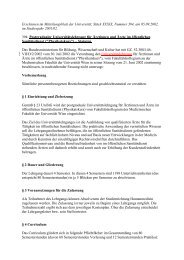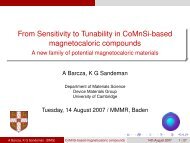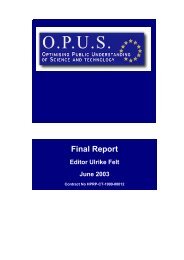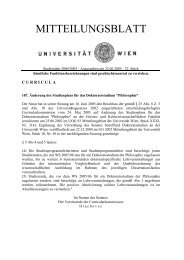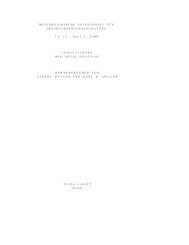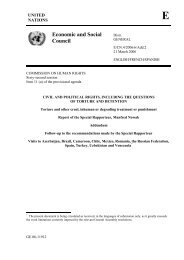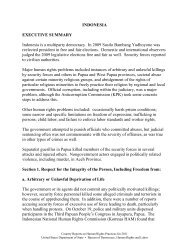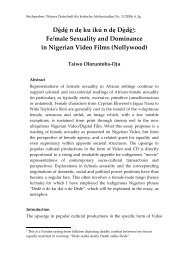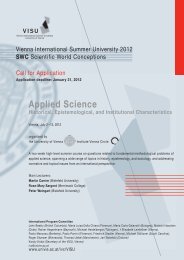(Stand: 25. Juli 2007) ANDERSON, Michael Alan ... - Universität Wien
(Stand: 25. Juli 2007) ANDERSON, Michael Alan ... - Universität Wien
(Stand: 25. Juli 2007) ANDERSON, Michael Alan ... - Universität Wien
Create successful ePaper yourself
Turn your PDF publications into a flip-book with our unique Google optimized e-Paper software.
MEDIEVAL & RENAISSANCE MUSIC CONFERENCE <strong>2007</strong> – WIEN, 7.-11. AUGUST ABSTRACTS<br />
we thus question the alleged date of birth of Morales and place it prior to 1500 since his<br />
ordination and the subsequent prebend he enjoyed in Plasencia could only have occurred<br />
around the age of 30.<br />
� �<br />
DONNELLY, Dan (McGill University, Montréal)<br />
Musica, Mensa, Meraviglia: The Ferrarese Banquets of Cristofaro di Messisbugo<br />
Freitag/Friday, 10.8., 11.45 Uhr, KuGe, SR 1<br />
A man of impeccable cultivation and unparalleled cultural sophistication, Cristofaro di<br />
Messisbugo (149?-1548) dominated the cultural life of the Este court at Ferrara for nearly<br />
three decades following his appointment as chief steward and head of household (scalco) in<br />
1519. His voluminous compendia have long been considered among the best contemporary<br />
records of the day-to-day operations of the court as an institution. Along the same lines,<br />
his Banchetti, compositioni di vivande, et apparechio generale, published posthumously in 1549<br />
(and subsequently reprinted more than a dozen times), provides some of the most fascinating<br />
first-hand accounts of the manner in which cultural events were integrated into the<br />
daily life of the Este family. One banquet it describes, given by Alfonso I’s son and heir<br />
Ercole in 1529, has been cited by Lewis Lockwood among others as a testament to the vibrant<br />
and innovative cultural environment of cinquecento Ferrara, but such references fail<br />
to take into account the greater cultural importance of the book as a whole. I will show<br />
that a more thorough reading of Banchetti reveals precisely the manner in which Messisbugo,<br />
the ideal scalco, used his prior experience as a court musician to integrate music,<br />
theatre, and food into a single, artistically unified complex of entertainments. In such a<br />
complex, the wonders of the table and the stage, united through the musical intermedi that<br />
traditionally accompanied both, worked in concert to instill an unprecedented sense of<br />
awe (meraviglia) in the spectator-participants, effectively combining all of the court’s resources<br />
in a monument to the grandeur and munificence of the Prince. Given a political<br />
environment that relied increasingly on keeping up appearances, this extraordinary skill<br />
explains how Messisbugo could rise to the station of palatine count, where a generation<br />
earlier he would have been regarded as little more than a servant.<br />
� �<br />
DUMITRESCU, Theodor (Universiteit Utrecht)<br />
The polyphonic Paschal Kyrie c. 1500: the compositional tradition and a new Low<br />
Countries fragment<br />
Freitag/Friday, 10.8., 15.00 Uhr, MuWi, HS 1<br />
The discovery of a set of leaves of polyphony bound into a 16th-century print now kept at<br />
the library of Durham University offers a starting point for considering a significant but<br />
under-explored compositional tradition. Housed at an early date in Brussels, the Durham<br />
copy of Joannes Magnus’s “Gothorum Sueonumque Historia“ (Rome, 1554) likely received<br />
its binding in the late 16th or early 17th century in the same region drawing upon locally-<br />
- 27 -




